#this includes access to resources etc etc
Explore tagged Tumblr posts
Text

Offerings

An important practice in hellenic Polytheism is the offerings. Many people already have an idea about what they are, so this post is more centered towards worshippers that stress around this concept since I'll be talking about how to handle it/how I handle it.
Offerings can range from a wide amount of things. A quick classification I can make up from the top of my head is: food offerings, other objects, and devotional acts.
When you first get introduced to hellenic Polytheism, food offerings appear as one of the main ways of building Kharis with the deities, since in general, that's what offerings do. The problem begins when we take libations and food as the better way to do offerings, putting them in some sort of subconscious pedestal over the other "methods".
Many followers can't afford to always do them to honor the gods, myself included. So, when all we see is an inability to offer things to our gods that way, it leads us to feel guilty and disappointed.
This is where I start to give tips from my own experience !
First, think of offerings as gifts. It is said to us that gifts don't always have to be something material to be significant. The same concept applies to offerings. I mentioned at the start that there were also other objects that could be given and devotional acts too. Intent is what matters. The gods don't care if you do offerings a certain way, but if the feelings are genuine from your part.
Other objects include jewelry/devotional jewelry, toys, books, etc. Basically, anything that isn't food. Devotional acts, as its name suggests, are activities that you can dedicate to your deities as long as it falls under their domain. Example: I have given Apollo a mouse fidget toy and also dedicate drawing, divination, dancing, etc.
It is as simple as that, trust me. It doesn't have to be elaborated. Now that gets me to the second point: check your resources.
You guys already know I struggled from following recon concepts and practices. You're totally free to follow them too if you can and want, but simply, some of us can't. Many sources for information about helpol come from a recon point of view, or simply others put things way more complicated/elaborated than they really are. Again, people are free to do them, but I'm focusing here on beginners/revivalists. Analyze your information and don't stay just with that. Search for easier ways to do things and overall avoid possible frustrations.
Getting back to my practice, I found out that libations didn't necessarily need to be poured out outside on the ground ! They could be poured down the sink or in a cup. Simple, right? This is mostly for those who still want to offer their gods food but in a more accessible manner. Another one is leaving the first or last bite of your food as an offering. (For Hestia, you leave both of those bites)
Note: Before applying these, know that rules still apply to Chthonic gods, not ingesting, eating, or drinking the offerings !
So now that you have both of those tips, I'll tell you one last thing: don't be afraid. It is also a shared sentiment that us helpols stress over our gods' images of us, our relationship with them, to treat them with respect and, overall, not fuck things up. Relax with your offerings, ease down. That constant worry also affects your feelings towards them, and we don't want that ! It is something that not only makes your deity happy, but you as well. The gods care about your happiness.
That's it for today ! If you want more of my rambles, feel free to interact with this post ♡ I wish you a good journey.

#Boo's rambles#hellenic polytheism#hellenic worship#hellenic community#hellenic deities#hellenic pagan#apollo#apollon
21 notes
·
View notes
Text
pls ignore me i'm just rambling but... did y'all know banning non-actors in rps actually limits the amount of poc we can bring in??? as (we all know) acting is very white-dominated!! and every other celebrity status is too??? and if you open up more options... more poc can be brought in!! just food for thought.
2 notes
·
View notes
Text
sure, we can laugh he thinks he's gonna get Greenland somehow, Panama Canal, etc
But also remember that, among many other things in its near thousand pages, Project 2025 specifically outlines and plans for everything up to boots-on-the-ground resource wars even against established allies.
And it maybe puts a bit more stark context to how he's already gunning for this shit before he's even sworn in.
Cheers! 🍻
#tw alcohol#us politics#like. i am NOT trying to get anyone to panic. the whole opposite of that.#the brakes are off. it's electric boogaloo time#we cope how we can#just try to brace for the drops. and keep all limbs inside the vehicle#and as always: find irl community/ies offline now. if only to supplement#for if/when digital is no longer available or accessible#ESPECIALLY if you are disabled or have disabled loved ones#know your local resources!! that includes charities and advocacy groups and libraries and warming centers and#and while im at it. learn YOUR SPECIFIC elected reps. watch them closely and write them OFTEN#email/call/etc#whatev#rambleramble bullshit time#i promise im not trying to be negative im very. Bracing Myself. planning to pace myself#just ... gonna take it one day at a time
5 notes
·
View notes
Text
URGENT: 🚨🚨EARN IT ACT IS BACK IN THE SENATE 🚨🚨 TUMBLR’S NSFW BAN HITTING THE ENTIRE INTERNET THIS SUMMER 2023
April 28, 2023
I’m so sorry for the long post but please please please pay attention and spread this
What is the EARN IT Act?
The EARN IT Act (s. 1207) has been roundly condemned by nearly every major LGBTQ+ advocacy and human rights organization in the country.
This is the third time the Senate has been trying to force this through, and I talked about it last year. It is a bill that claims "protects children and victims against CSAM" by creating an unelected and politically appointed national commission of law enforcement specialists to dictate "best practices" that websites all across the nation will be forced to follow. (Keep in mind, most websites in the world are created in the US, so this has global ramifications). These "best practices" would include killing encryption so that any law enforcement can scan and see every single message, dm, photo, cloud storage, data, and any website you have every so much as glanced at. Contrary to popular belief, no they actually can't already do that. These "best practices" also create new laws for "removing CSAM" online, leading to mass censorship of non-CSAM content like what happened to tumblr. Keep in mind that groups like NCOSE, an anti-LGBT hate group, will be allowed on this commission. If websites don't follow these best practices, they lose their Section 230 protections, leading to mass censorship either way.
Section 230 is foundational to modern online communications. It's the entire reason social media exists. It grants legal protection to users and websites, and says that websites aren't responsible for what users upload online unless it's criminal. Without Section 230, websites are at the mercy of whatever bullshit regulatory laws any and every US state passes. Imagine if Texas and Florida were allowed to say what you can and can't publish and access online. That is what will happen if EARN IT passes. (For context, Trump wanted to get rid of Section 230 because he knew it would lead to mass govt surveillance and censorship of minorities online.)
This is really not a drill. Anyone who makes or consume anything “adult” and LGBT online has to be prepared to fight Sen. Blumenthal’s EARN IT Act, brought back from the grave by a bipartisan consensus to destroy Section 230. If this bill passes, we’re going to see most, if not all, adult content and accounts removed from mainstream platforms. This will include anything related to LGBT content, including SFW fanfiction, for example. Youtube, Twitter, Reddit, Tiktok, Tumblr, all of them will be completely gutted of anything related to LGBT content, abortion healthcare, resources for victims of any type of abuse, etc. It is a right-wing fascists wet dream, which is why NCOSE is behind this bill and why another name for this bill is named in reference to NCOSE.
NCOSE used to be named Morality in Media, and has rebranded into an "anti-trafficking" organization. They are a hate group that has made millions off of being "against trafficking" while helping almost no victims and pushing for homophobic laws globally. They have successfully pushing the idea that any form of sexual expression, including talking about HEALTH, leads to sex trafficking. That's how SESTA passed. Their goal is to eliminate all sex, anything gay, and everything that goes against their idea of ‘God’ from the internet and hyper disney-fy and sanitize it. This is a highly coordinated attack on multiple fronts.
The EARN IT Act will lead to mass online censorship and surveillance. Platforms will be forced to scan their users’ communications and censor all sex-related content, including sex education, literally anything lgbt, transgender or non-binary education and support systems, aything related to abortion, and sex worker communication according to the ACLU. All this in the name of “protecting kids” and “fighting CSAM”, both of which the bill does nothing of the sort. In fact it makes fighting CSEM even harder.
EARN IT will open the way for politicians to define the category of “pornography" as they — or the lobbies that fund them — please. The same way that right-wing groups have successfully banned books about race and LGBT, are banning trans people from existing, all under the guise of protecting children from "grooming and exploitation", is how they will successfully censor the internet.
As long as state legislatures can tie in "fighting CSAM" to their bullshit laws, they can use EARN IT to censor and surveill whatever they want.
This is already a nightmare enough. But the bill also DESTROYS ENCRYPTION, you know, the thing protecting literally anyone or any govt entity from going into your private messages and emails and anything on your devices and spying on you.
This bill is going to finish what FOSTA/SESTA started. And that should terrify you.
Senator Blumenthal (Same guy who said ‘Facebook should ban finsta’) pushed this bill all of 2020, literally every activist (There were more than half a million signatures on this site opposing this act!) pushed hard to stop this bill. Now he brings it back, doesn’t show the text of the bill until hours later, and it’s WORSE. Instead of fixing literally anything in the bill that might actually protect kids online, Bluemnthal is hoping to fast track this and shove it through, hoping to get little media attention other than propaganda of “protecting kids” to support this shitty legislation that will harm kids. Blumental doesn't care about protecting anyone, and only wants his name in headlines.
It will make CSAM much much worse.
One of the many reasons this bill is so dangerous: It totally misunderstands how Section 230 works, and in doing so (as with FOSTA) it is likely to make the very real problem of CSAM worse, not better. Section 230 gives companies the flexibility to try different approaches to dealing with various content moderation challenges. It allows for greater and greater experimentation and adjustments as they learn what works – without fear of liability for any “failure.” Removing Section 230 protections does the opposite. It says if you do anything, you may face crippling legal liability. This actually makes companies less willing to do anything that involves trying to seek out, take down, and report CSAM because of the greatly increased liability that comes with admitting that there is CSAM on your platform to search for and deal with. This liability would allow anyone for any reason to sue any platform they want, suing smaller ones out of existence. Look at what is happening right now with book bans across the nation with far right groups. This is going to happen to the internet if this bill passes.
(Remember, the state department released a report in December 2021 recommending that the government crack down on “obscenity” as hard the Reagan Administration did. If this bill passes, it could easily go way beyond shit red states are currently trying. It is a goldmine for the fascist right that is currently in the middle of banning every book that talks about race and sexuality across the US.)
The reason these bills keep showing up is because there is this false lie spread by organizations like NCOSE that platforms do nothing about CSEM online. However, platforms are already liable for child sexual exploitation under federal law. Tech companies sent more than 45 million+ instances of CSAM to the DOJ in 2019 alone, most of which they declined to investigate. This shows that platforms are actually doing everything in their power already to stop CSEM by following already existing laws. The Earn It Act includes zero resources for proven investigation or prevention programs. If Senator Bluementhal actually cared about protecting youth, why wouldn’t he include anything to actually protect them in his shitty horrible bill? EARN IT is actually likely to make prosecuting child molesters more difficult since evidence collected this way likely violates the Fourth Amendment and would be inadmissible in court.
I don’t know why so many Senators are eager to cosponsor the “make child pornography worse” bill, but here we are.
HOW TO FIGHT BACK
EARN IT Act was introduced just two weeks ago and is already being fast-tracked. It will be marked up the week of May 1st and head to the Senate floor immediately after. If there is no loud and consistent opposition, it will be law by JUNE! Most bills never go to markup, so this means they are putting pressure to move this through. There are already 20 co-sponsors, a fifth of the entire Senate. This is an uphill battle and it is very much all hands on deck.
CALL YOUR REPRESENTATIVES.
This website takes you to your Senator / House members contact info. EMAIL, MESSAGE, SEND LETTERS, CALL CALL CALL CALL CALL. Calling is the BEST way to get a message through. Get your family and friends to send calls too. This is literally the end of free speech online.
(202) 224-3121 connects you to the congressional hotline. Here is a call script if you don't know what to say. Call them every day. Even on the weekends, leaving voicemails are fine.
2. Sign these petitions!
Link to Petition 1
Link to Petition 2
3. SPREAD THE WORD ONLINE
If you have any social media, spread this online. One of the best ways we fought back against this last year was MASSIVE spread online. Tiktok, reddit, twitter, discord, whatever means you have at least mention it. We could see most social media die out by this fall if we don't fight back.
Here is a linktree with more information on this bill including a masterpost of articles, the links to petitions, and the call script.
DISCORD LINK IF YOU WANT TO HELP FIGHT IT
TLDR: The EARN IT Act will lead to online censorship of any and all adult & lgbt content across the entire internet, open the floodgates to mass surveillance the likes which we haven’t seen before, lead to much more CSEM being distributed online, and destroy encryption. Call 202-224-3121 to connect to your house and senate representative and tell them to VOTE NO on this bill that does not protect anyone and harms everyone.
43K notes
·
View notes
Text
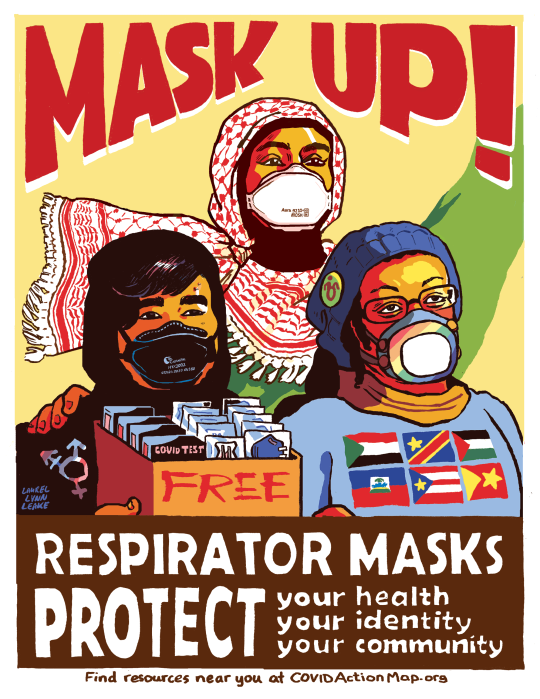
MASK UP FOR GLOBAL LIBERATION
Protect your community by wearing N95s and KN95s when meeting indoors or in crowds! The more of us mask up, the less we get sick, the harder it is for police to surveil us, and the safer we make our shared spaces for our disabled and immuno-compromised comrades and loved ones.
Get started by finding local mask resources on the global COVID Action Map (you can also submit groups to be added). If you have the means, donate masks and tests to your local orgs and encourage accessibility so we can ALL join the fight (bringing in interpreters/translators and medics, ensuring accessibility for wheelchairs/mobility devices, offering child care, filtering the air indoors, setting up virtual options etc).
UPDATE: Download this 8.5"x11" poster for free on itch.io to print and distribute! Includes files suitable for color, black and white, and risograph printing. Any donations will go to printing costs, or buying masks for my local mutual aid groups.
Pandemics have no borders, and all our struggles are united!
[ID: A poster declaring “MASK UP” in red above 3 figures from the waist up, each wearing a different respirator mask. The top figure is an Arab person wearing a fluttering red and white kufiyah over a black hijab and red dress, as well as an Aura 9210+ N95 mask. They steady themselves with one hand on the lower left figure, and raise the other one up triumphantly. The left person is a fat Asian teenager wearing a black hoodie with a genderqueer symbol on the shoulder, and a black Laianzhi HYX1002 KN100 mask. They are holding a box labeled FREE that’s full of COVID-19 Rapid Tests, and two different kinds of plastic-wrapped N95s. The last figure is a middle aged Black person in a power chair, wearing a Flo Mask with a customised rainbow cover, a dark blue winter hat with a Disability pin on it, and a blue shirt featuring 6 countries flags from R to L: Sudan, Democratic Republic of the Congo, Palestine, Haiti, Puerto Rico, and Tigray, Ethiopia. Underneath reads: “RESPIRATOR MASKS PROTECT: your health, your identity, and your community. Find resources near you at COVIDActionMap.org”]
#covid resources#covid 19#covid isn't over#free palestine#free sudan#free haiti#free the congo#free tigray#free puerto rico#global liberation#community care#covid cautious#protest resources#illustration
6K notes
·
View notes
Text
LA Wildfire Resources
this is a collection of all of the information and resources i've found to help those affected by the los angeles count wildfires. this is not a completed list, and you are welcome to send me an ask with any additional links, fundraisers, information, or other resources that you know of and i will update this post accordingly. if there are any missing or incorrect links, please let me know. stay safe out there 💜
──────────────────────────────────────────
Live Updates on the Southern California wildfires & Evacuation Orders
LA Scanner - Coverage of Pursuits, Crimes, Wildfires and More.
2025 Los Angeles Fires - Resources for Californians impacted by Los Angeles Fires.
LA Wildfire Resource Center - Resource navigator for finding emergency resources and support services.
──────────────────────────────────────────
Mutual Aid Los Angeles & their Fire & Wind Storm Spreadsheet - An ongoing spreadsheet of resources such as shelter info, animal boarding info, addresses for distribution centers, volunteer opportunities, etc.
LAFD Emergency Funding Alert & Fire Zone Map - Donations to help support the Los Angeles Fire Department.
The Partnership for Inclusive Disaster Strategies - Lists of evacuation shelters and hotlines for those who are disabled and in impacted by the fires.
Los Angeles Regional Food Bank
Thread of mutual aid groups assisting through Los Angeles
CleanAirLA & MaskBloc LA - Mutual aid project to distribute free masks and respirators in the so-called Los Angeles area. They are currently taking donations for masks.
MaskBloc LA & their Mask Requests and Volunteer Interest - A form to fill out if you need masks or want to volunteer.
List of shelters, animal boarding, distribution hubs, and free items
Pacsun providng clothes and listing organizations to donate to
World Central Kitchen - Donate to support their efforts in Southern California to support first responders and families impacted by wildfires in the Los Angeles area.
Thread of organizations to donate to - Thread including links to disaster relief, firefighter aid, food banks, first responders, etc.
SoCal Wildfires: How You Can Help - Article including links and info for Californians. Links are also included in the Thread of organizations to donate to above.
Pete and Thomas Foundation supporting Pasadena Humane & LA Animal Care - How to support, injured wildlife hotline, and listed shelters for large and small animals.
Thread of GoFundMes to support people affected by the wildfires
What to keep in a grab & go bag - List of things to keep in a easily accessible bag in case of emergency evacuation.
Displaced Black Families GoFund Me Directory - Spreadsheet dedicated to black families devastated by the Altadena fires.
Advice from a survivor of the 2017 Thomas Fire on insurance, rebuilding, etc.
California Volunteers - Donate, organize, and volunteer for wildfire recovery here.
Baby2Baby Disaster Relief and Emergency Response Program - Donate to help distribute supplies to children impacted by the wildfires.
Guitar Center is replacing instruments lost as a result of the LA wildfires
Sunny Optometry is offering support to those in need of glasses, contact lenses, eye drops, face masks, and wi-fi
Stratia is offering a free place to work if you need a work space with wifi right now, and donation drop off/sorting + storage site for people who organize.
Seconds Market & their Match Donation Program - A program designed to directly connect donors with individuals affected by the LA fires.
Anti-Recidivism Coalition & their donation page - Donate to help support the incarcerated fire crews, including the 30 young men from Pine Grove currently out fighting the LA fires.
Spreadsheet of Free Mental Health Services for the LA Wildfire Crisis
Tips from an attorney on dealing with insurance companies
County of LA Vital and Property Records Access - LA County residents directly impacted by the fires can request property and vital records free of charge to help with recovery efforts.
Azay in Little Tokyo, LA - Donate to help provide free meals to evacuees, first responders, volunteers, folks who can’t leave their homes, and their houseless neighbors.
#los angeles#la wildfires#palisades fire#pacific palisades#california fires#la resources#altadena fire
1K notes
·
View notes
Text

butch trans women: a butch voices 2011 panel
…the transcript!
as far as i can tell, the captions on youtube are fairly accurate, but creating a full transcript was still important to me for a few reasons: accessibility, archival, & resources. 1) especially for people who can’t listen to the audio, i think the transcript is a lot easier to read with punctuation, speaker notation, etc. 2) i’m always concerned about the possibility of youtube videos being taken down (by the creator or more likely youtube itself) & text documents are a lot easier than video to share & store, including offline. 3) whenever possible i incorporated updated & archived links of resources mentioned as well as pdf backups.
watch, read, share with your friends, add to your trans microlibrary (@thetransfemininereview), print out & put on your bookshelf, & most importantly remember butch trans women are a vital part of butch/femme history, present, & future❣️
google doc / pdf link
#butch transfem#transfem butch#butch trans woman#butch trans women#butch#transfem#butch history#queer history#trans history#trans woman#trans women#butch/femme#butch4femme#butch4butch#butch4both#butch4all#t4t#t4t history#butch/femme history#trans literature preservation project#butch voices#butch voices 2011#mac.txt#mac’s bookshelf#they are our stigmata#tobi hill meyer#twiggy danger#brynn cassidy west#oona fei coatl#courtney trouble
482 notes
·
View notes
Text
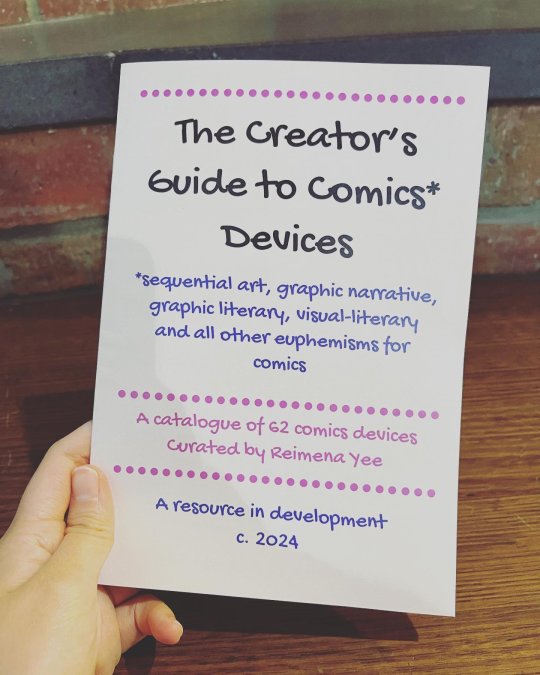
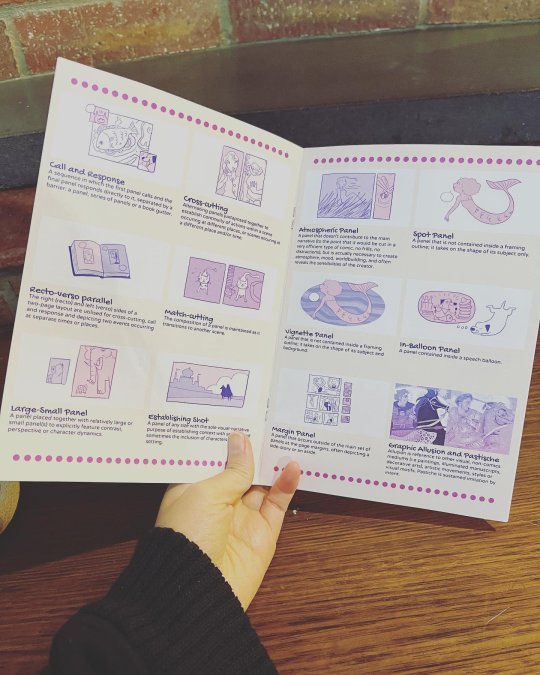

Idk if I talked about this here, but for the past 3 years I've been quietly developing a particular kind of comics taxonomy: identifying, naming and describing the visual-literary devices used in comics. Most of them are devices appropriated and adapted from other mediums, like poetry, rhetoric, cinema, etc - but quite a few are unique to comics. My intent is to give language not just for comics creators when they need to articulate their authorial choices, but for critics, scholars and teachers to talk about comics as a visual-literary art form.
Anyway, the research has gotten to the point where it's ready for the public. My plan is for this resource to be delivered in the form of a Wikipedia, online database, basically an accessible website that contains all the information related to the devices, including working examples from other graphic novels, webcomics, etc. It's STILL not ready yet - Idk when it's gonna debut, but I've recently secured an opportunity that will make progress move faster.
This zine right here is both soft-launch promo + a fancy business card for the Comics Devices guide. It's meant to pitch my research and act as a quick reference type of thing for folks. I'm only able to sell this in person in Australia, but folks in the US might get an edition soon (related to aforementioned opportunity).
But yeah. Big comics stuff happening.
3K notes
·
View notes
Text



Palace of the Republic, Berlin
The right to work at a job of one’s own choice was guaranteed by the East German constitution (Aus erster Hand, 1987). While there were some (mostly alcoholics) who continuously refused to show up for jobs offered by the state, their numbers represented only about 0.2% of the entire East German work force, and only 0.1% of the scheduled work hours of the rest of the labor force was lost due to unexcused absences (Krakat, 1996). These findings are especially noteworthy, given that people were generally protected from being fired (or otherwise penalized) for failing to show up for work or for not working productively (Thuet, 1985). The importance of the communist characteristic of full employment to workers is reflected in a 1999 survey of eastern Germans that indicated about 70% of them felt they had meaningfully less job security in the unified capitalist country in the 1990s than they did in communist East Germany (Kramm, 1999)
The Triumph of Evil, A. Murphy (2002)
The GDR had more theatres per capita than any other country in the world and in no other country were there more orchestras in relation to population size or territory. With 90 professional orchestras, GDR citizens had three times more opportunity of accessing live music, than those in the FRG, 7.5 times more than in the USA and 30 times more than in the UK. It also had one of the world’s highest book publishing figures. This small country with its very limited economic resources, even in the fifties was spending double the amount on cultural activities as the FRG. Every town of 30,000 or more inhabitants in the GDR had its theatre and cinema as well as other cultural venues. [...] Subsidised tickets to the theatre and concerts were always priced so that everyone could afford to go. Many factories and institutions had regular block-bookings for their workers which were avidly taken up. School pupils from the age of 14 were also encouraged to go to the theatre once a month and schools were able to obtain subsidised tickets. [...] All towns and even many villages had their own ‘Houses of Culture’, owned by the local communities and open for all to use. These were places that offered performance venues, workshop space and facilities for celebratory gatherings, discos, drama groups etc. There was a lively culture of local music and folk-song groups, as well as classical musical performance.
Stasi State or Socialist Paradise? The German Democratic Republic and What Became of It, Bruni de la Motte and John Green (2015)
Work itself was elevated to a place of pride and esteem and, even if you were in a lower paid job, you were valued for the work you did as a necessary contribution to the functioning of society. The socialist countries were also designated ‘workers’ states and it was not merely an empty phrase when the GDR government argued that the workers, who produced the commodities that society needed, should be placed at the forefront of society. Those who did heavy manual work, like miners or steel workers, enjoyed certain privileges: better wages and health care than those in less strenuous or dangerous professions. The GDR had one of the most comprehensive workers’ rights legislation of any other country in the world. From 1950 onwards, there was a guaranteed right to work. This right applied to everybody, including disabled people and those with criminal records. Employers were made responsible for the training and integration of everyone. This meant that everybody felt they had a place in society and were needed. This was particularly important for disabled people and those who wanted a new start in life after being convicted of a crime. Working people were under a much more relaxed discipline in the workplace. Because there was job security and it was almost impossible to be sacked, an authoritarian discipline was difficult, if not impossible, to achieve. In Western countries work discipline is invariably enforced by the implicit threat of job loss. In the GDR, only in cases of serious misconduct or incompetence would employees be sacked. There were individual cases where employees were sacked illegally for what was considered ‘oppositional’ or ‘anti-state behaviour’, but usually the sanction would involve demotion or being transferred to a different workplace. This job security gave employees a sense of confidence and a considerable power in the workplace. It meant that workers could and would voice criticism over inefficiencies or bad management without having to fear for their job. Job security and lack of fear about losing it was probably one of the greatest advantages the socialist system offered working people. Even in cases where a worker was sacked from one job, other alternative work would be offered, even if not on the same level. The other side of the coin was that there was also a social obligation to work - the GDR had no system of unemployment benefit, because the concept of unemployment did not exist.
Stasi State or Socialist Paradise? The German Democratic Republic and What Became of It, Bruni de la Motte and John Green (2015)
407 notes
·
View notes
Text
Falmer appearance and attire headcanons
(click on drawings for more details and notes!)
Hair
In Skyrim, we pretty much only see two hair styles to go off of: completely bald and the hair the "shaman" have (which are also the only females we see (a post for another day)).


In concept art, particularly Adam Adamowicz's, we see more potential hairstyles. He draws it as wispy and messy, as well as containing braids and the ties we see in the shaman in the game. This art is largely what defines my own interpretation of their hair.


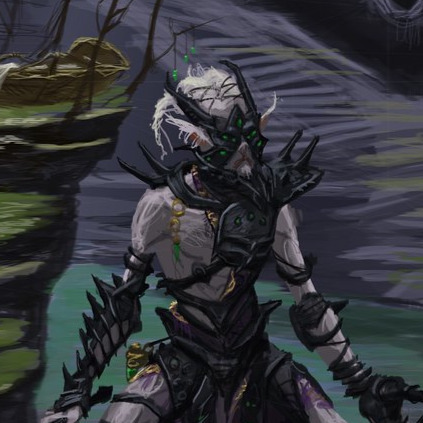
I picture the typical Falmer hair as wavy, thin, wispy, and looking frizzy. Given the high number of hairless Falmer we see, I imagine baldness is common, particularly among males, and sometimes among females. Their hair can be commonly styled into braids or knots to keep it under control.
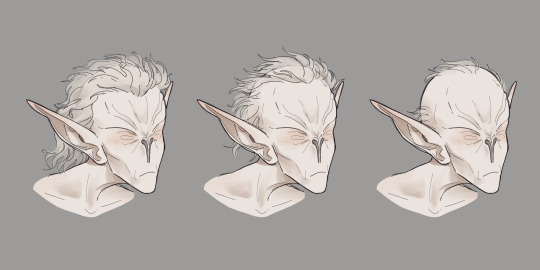
The ability to grow long, thick hair is less common, but those who can tend to style it in other unique ways. Especially among females, long hair is commonly styled into large dense locs (akin to a Polish plait) and held into shapes using ropes or leather ties.

(While I think the intention with the way their hair is drawn and modelled in the game models and concept art was that it was braided and held up with those ties, before looking at it closely I always sorta interpreted it as too stiff to just be braided. As a result, I developed the locs headcanon and have become kinda attached to it even though I have 0 in game or lore support for it)
Materials
The material used in their clothing is obviously dependent on what is accessible to them, and given their unique situation that makes the materials they use and value unique as well. In Skyrim, we see that almost all of their armor (which is mostly what we see them wearing) and homes are made of chaurus chitin (and potentially shellbug chitin), so this is likely the most common resource available to them for non-combative coverings as well. Other materials from their arthropods companions could include their cocoons, unhatched eggs, etc.
Bones from other creatures (draugr, skeevers, trolls, adventurers, bandits, etc.) underground or from aboveground raids could also be used fairly often. These could also provide a source of leather or fur, albeit not a lot of it.
Falmer groups and subcultures inside or in close proximity to Dwemer ruins probably make regular use of the materials present in those ruins as well. With all the metal and machinery present in Dwemer ruins, metal probably makes regular appearances in their clothing (and general decorations) even if they can't manipulate it themselves. Falmer more separated from Dwemer ruins would make much lesser use of these materials, however. Additionally, We see implications of Falmer preparing, cooking, and potentially cultivating fungus in-game, but see nothing indicating they have any plants in their diet, and therefore it is unlikely they regularly make or use textiles or fabrics in their clothing, and if they do they likely come form Dwemer ruins or raided adventurers/bandits/settlements from the surface.
On that note, we know that there have supposedly been incidents of Falmer coming to the surface to attack its inhabitants and travelers, as well as instances of them killing bandits, adventurers, and researchers who venture below, so it's not far fetched to believe that they have access to some materials from the surface. This could give them some access to furs from surface animals, beads, glass, jewelry, textiles, metal objects, etc. they might not otherwise have access to. The rarity of these material among the Falmer would depend on the amount of access any given group of Falmer have to the surface, but among many of them these materials could be seen as more valuable for their rarity and the difficulty to gain them.
While gemstones and ore might be accessible from both natural deposits and underground ruins, unless they had some kind of auditory function or unique texture, they might not have much value to Falmer.
General Attire/Accessories
I like to imagine that the Snow Elves, and by extension the Falmer, have an innate cold resistance in the same way Nords do, and therefore don't require clothes for the purpose of warmth even in the chilly caves of Skyrim. Additionally, their blindness likely means that wouldn't dress for visual aesthetic either. My thoughts are that they are then left with the sense of sound and touch to communicate with each other, and their clothing and accessories could reflect that.
Falmer clothing, decoration, and society in general is very heavily based on touch and texture and little on appearances. They touch each other very often for both communication, movement, and just general day-to-day interactions, and their clothes isn’t very modest, but the tactile patterns and materials used can communicate certain things such as position in society, “wealth”/power, whether they are taken, single, pregnant, with a child, etc., their roles, their age, notable achievements/skills, who is who, etc. on both their clothes and buildings. The more noise one makes, the more attention they draw and the more they drown out other noises, and the more noise making things they can “afford” to have, so the amount of noise one makes in a Falmer settlement is a status symbol. Certain types of noises or noise makers are more coveted than others (chitin beads are common, while furs are less common, and materials only gained from raiding the surface are rare and coveted).
Some noise making accessories could include:
Dangling metal, bones, beads, chitin, etc. that hangs off of their clothing or ears and jingle/clank against each other (in my drawing I show them as pretty uniform in shape and size, but they would probably be much more irregular than I depicted them)
Bells (metal or other materials) that are affixed to or dangle off of their clothing or as earrings.
Hollow bracelets, anklets, necklaces, or other accessories that are filled with rocks or beads.
Rattles tied to the body (made of chitin, dried hollow chaurus eggs, dried chaurus cocoons, beads, etc.) with leather or rope.
Flute or whistle like tubes made of metal, chitin, or dried and treated tube-like fungus that makes a woodwind-esque noise when air passes through it in a certain way. They have been designed to make noise easily from even the slightest movements.
Dried grasses (more temporary) tied to the body that make a swishy noise. More permanently, a similar thing can be achieved with hair. The hair can be sourced from Falmer (either through just cutting hair or through taking it from fallen enemies) or killed humans/mer/draugr. That sort of thing can also act as a kind of trophy.
Necklaces with various materials dangling close together that jingle against each other.
Various materials can be tied into braids or the leather ties in their hair as well.
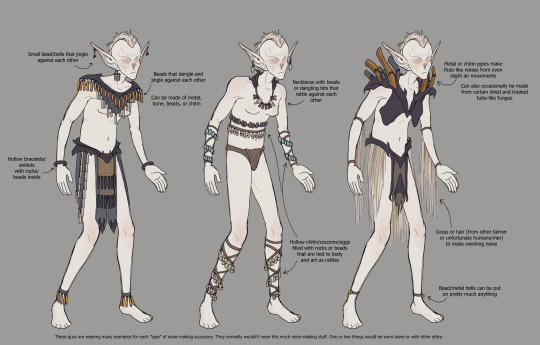
Some textural accessories could include:
Beads. Since they wouldn't have the ability to tell the color of the beads, the patterning of beadwork would be based on the roughness, material, size, or shape of the beads. (I'm sorry I suck as drawing beads)
Furs. This wouldn't be as common since the Falmer likely don't have too much interaction with furry mammals, but some they may have access to that are big enough to make clothing/accessories out of include skeevers or trolls (and potentially rarely animals from the surface). A potential meaning of wearing furs could be as hunting trophies, but it could have other meanings as well.
Chaurus chitin would like be the most common material in Falmer attire, and depending on the part of the chaurus body, the size of the chaurus, or the life stage of the chaurus it was sourced from it could have different textures. Some chitin parts could include large spikes and deep groves, while other parts could be smoother and less rough. The use of this chitin in clothing could take advantage of this contrast in textures. Additionally, chitin or shells from shell bugs might be a different texture from the chaurus chitin. (it's unclear to me whether shell bugs are exclusive to the caves around the Forgotten Vale or if we should consider them distributed throughout Skyrim's underground)
The placement of textured components on the body could have their own meaning to it alongside what accessories or textures are being used.
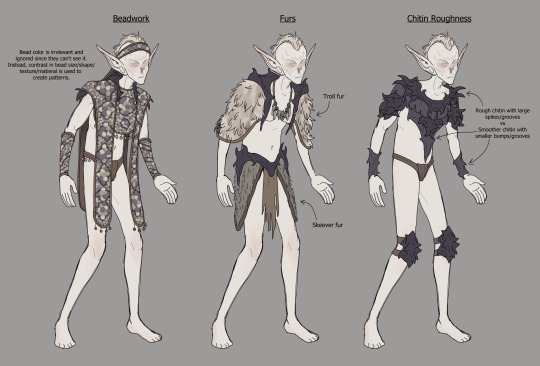
Specific Falmer Subcultures
While most Falmer settlements we see in Skyrim are just a small-ish collection of huts and chaurus corrals, there are two distinctive settlements that are larger, seemingly more organized, and I like to think have their own distinct subcultures worth mentioning: Blackreach and the Forgotten Vale. The unique scope and environment of these Falmer cities (as I like to think of them) could lend to unique clothing cultures as well.
The Falmer of Blackreach have access to a vast Dwemer settlement and have has the space to spread out throughout it more fully since it seems to be more in tact than other Dwemer ruins we see. These guys would likely have a clothing culture much more heavily based on what the can access from these Dwemer ruins (metal scraps, leftover fabrics, etc.)
The Falmer of the Forgotten Vale would also have access to unique resources, such as Vale deer, Vale sabre cats, and frost giants for fur and leather. Additionally, materials accessed from the Chantry of Auri-El such as textiles from clothing, bedding, tapestries, etc. could give them a greater access to fabrics than other Falmer groups. We don't see many close Dwemer settlements to the Vale, so they would have less Dwemeri influence in their clothing than other Falmer groups.
I like to think that the Falmer's evolution exclusively underground has made them poorly equipped to handle the outdoors during the day and has made them particularly susceptible to sunburn, necessitating the need for covering for those in the Forgotten Vale who have significant settlements outdoors. With greater access to textiles and leather, they could use them as coverings when outdoors.
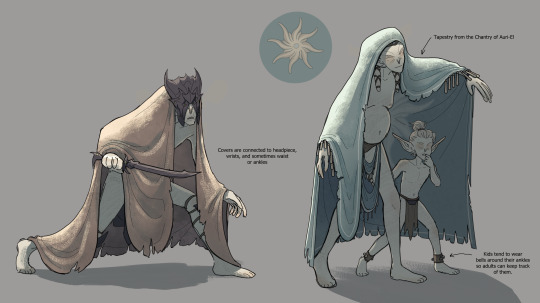
Armor
I actually have very few notes on armor, for two reasons. 1) I hate designing and drawing armor. It is the bane of my existence. 2) I really like the armor they have in game! I think they look awesome aesthetically, and I like how clearly they are made from chaurus chitin. Per usual, Adam Adamowicz's designs seem to have been the major inspiration for the Falmer armor, and he did a great jobs (even if it isn't the most functional looking armor ever).
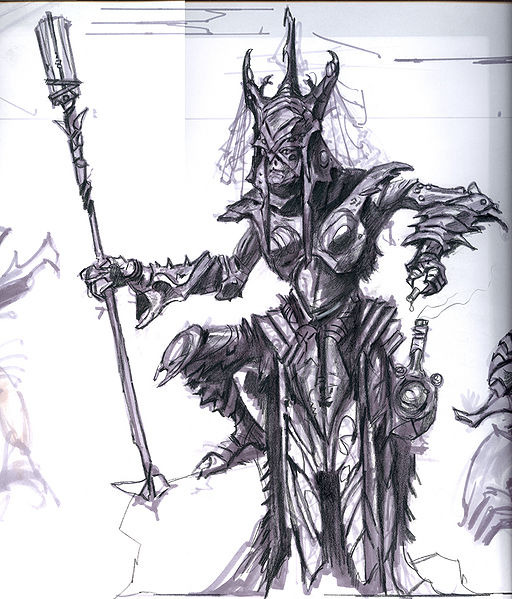
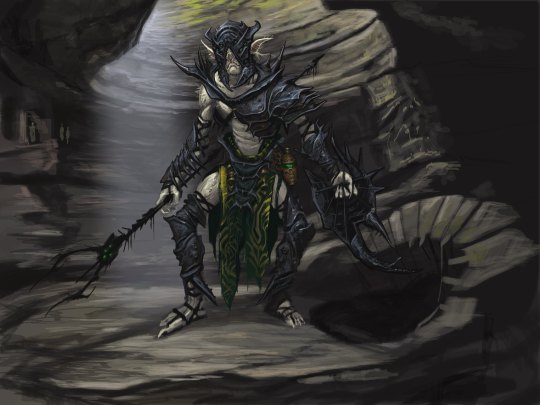

(off topic but I also just want to add that he draws them with little hairs and tufts on their ears and I love it. ok that is all)
I do have a few thoughts about armor though.
Even attire made of textiles make noise when someone moves in them, and I can imagine moving around in armor, especially armor made of hard, insect shells would make a lot of noise when someone moves around in it. When you're relying on sound to navigate your environment and pinpoint potential threats or targets, wearing something making a lot of noise would not be ideal. On the other hand, getting into a fight unarmored would be a problem.
So here's my solution: heavy armor (see below) would only be worm within the camps/settlements where noise was already high and space is more cramped (and therefore more risky in a fight) as a sort of guard in case they were attacked. Those guarding the settlements along the outside might still wear armor as well, but less of it. Those going out to scout or hunt (if they do hunt) would wear as little armor as possible, and try to wear it strategically so that it wouldn't rub against itself and make noise. This is why most Falmer we encounter in the game are wearing little except for loin cloths and kneepads.


One more idea I have for armor is a specific armor piece. On the note of guarding or protecting a camp or settlement, I imagine the noises of it all (especially with the noise based headcanons I've laid out here) would make it hard to actually catch any potential threats when you can't see. A large slightly concave piece of armor worn behind the head could block out noises from behind the wearer, as well as a help focus sounds ahead of them.
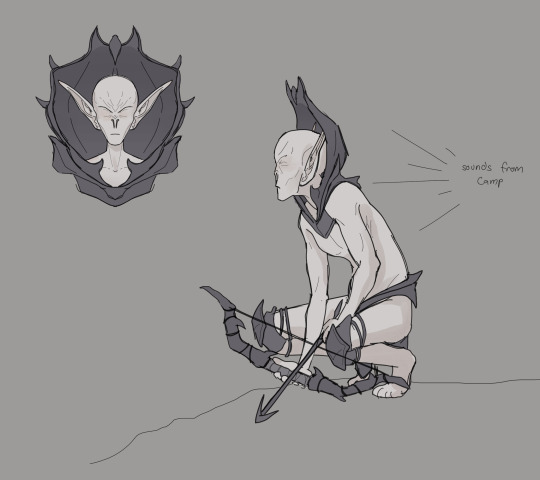
That is all! Thank you for reading! A lot of these concepts around the culture of sound I think could also be applied to their buildings and even a culture of music, but those are posts for another time.
All of the concept art I used was taken from here and all of the Skyrim screenshots are from UESP.
#skyrim#tes#the elder scrolls#falmer#skyrim headcanon#tes headcanons#headcanon#sorry this is long (but not really)#i just cant express my thoughts like a normal person. college conditioned me to format everything like an essay where i have to provide#sources and shit lol#also im kinda autistic about falmer#i appreciate those of you who read it all!#mine#adam's concept art makes me feel very validated in my echolocation headcanon because its very obvious he references bats in their face#which is another post idea i have for another day#my art
1K notes
·
View notes
Text
So, Things Are Terrible and You Want to DO SOMETHING
The election is over and, ah...did not go well. While a lot of folks are doing a post mortem of the campaigns and trying to understand what happened with the vote and fighting over who shoulders the blame, we've gotta turn an eye toward the future and figure out, okay fam, where the fuck do we go from here.
I don't have all the answers on this, and I'm not an authority by any means, I'm just a horror author with a blog. But I've been thinking a lot about it and I wanted to share my thought process with others who might want to DO SOMETHING but feel they're spinning their wheels.
Buckle in. This will be a long one.
Step One: Understand the actual risks and stakes.
I think it is very easy to start panicking now about the worst possible case scenario -- jackbooted military busting into the door to disappear everyone who ever said something mean about Trump or bought a banned book or something -- and let fear turn into inaction.
I'm not saying things can't get that bad, and I'm not saying that it won't be absolutely terrifying right out the gate for some particularly at-risk groups -- but the distance between "now" and "V for Vendetta" is long and filled with a lot of intermediary steps. There will be so many opportunities to prevent the worst case scenario.
I say this because, if your mental image of "Bad Things Happening" is The Purge, it will be easy to wake up on inauguration day, look outside to see that the world is not on fire, think, hey, maybe things will be okay after all, and then completely disengage. Alternatively, you might feel so frozen with terror at the possibility of persecution that you do nothing. This is why people are saying: don't obey in advance.
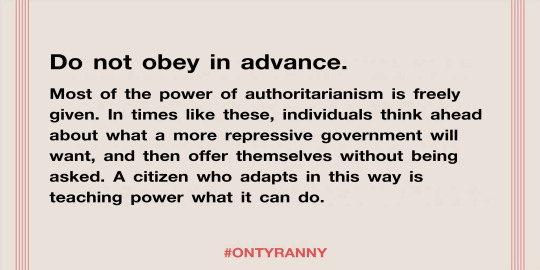
It is essential for those of us with more privilege to use it to take care of those who are more vulnerable.
So. Who is most vulnerable? What does that vulnerability actually mean? What are the most likely risks of Trump's presidency? Here's a Guardian article that I think does a good job of summarizing some of the main issues. Go read that, then come back here.
Step Two: Take steps to protect yourself
You've gotta put your oxygen mask on first, right? So before you start getting involved in other causes, figure out what risks YOU are at, immediately, and do as much as you can to secure yourself. Some potential action steps depending on your circumstance may include:
Renewing your passport (helpful for leaving the country, but also for gender/name change purposes)
Getting vaccines / boosters
Securing birth control
Ensuring your necessary papers (birth certificates etc.) are where you have access to them.
Drawing up legal paperwork for spouses/partners (always a good idea, a helpful safety measure in case you lose marriage rights)
Bolstering your data privacy and online security. Here's a step-by-step guide I found that could help with that.
The specific steps you need to take here depend on what risks you, personally, face. You'll want to do some more research into this for your particular scenario.
No matter who you are, though, it's probably a good idea to start saving money and being a little more conservative with your spending and/or pay down debts to free up some cash. You don't know what kind of emergency may befall you, and having spare money for an emergency is never a bad idea.
There is a possibility that the cost of many things you rely on might go up, if Trump goes through with his tariffs plan. You will want to plan for that.
Food costs may also rise due to tariffs (we import a lot of food from Mexico and Latin America for example) as well as a loss of immigrant labor. There is also a possibility that food safety standards could fall due to overturning regulations. Now would be a good time to look into local food resources like farm share/CSA, community farms, etc., and to stock up on a few key staples like rice and beans.
Okay. Now that YOU are reasonably safe...what can you do to protect your community?
Step Three: Get Involved
Here is your mission: You need to stay engaged enough to know what's going on, without burning yourself out or exhausting yourself, and to take actual decisive actions instead of wasting your energy arguing on the internet.
Got that? Okay. Good. Here are some action steps:
Support independent journalism. Subscribe to local papers, donate to and watch public broadcast programming. I signed up for news from ProPublica, for example, as well as the news-roundup service What The Fuck Just Happened Today. The goal is to stay informed without falling down an endless rabbit hole of upsetting information.
Share news and resources with others in your circle. This can be a good use of social media. It's what I am doing right now!
If it is safe for you to do so, challenge and educate your friends/family members/neighbors/coworkers. Only if it is safe for you to do so. Do not put yourself at risk doing this. And do not waste your time arguing with people who are unlikely to change. But if you have well-meaning people in your life who you think could be won over, look for opportunities to do this - the right way. I've had some success with this, I will probably write a guide about it in the future. In the meantime, here's a good article that can help.
Join local grassroots activism groups. You'll have to do some work to decide what groups to join and which causes you want to support, because you cannot do everything. But there are tons of organizations taking direct action in all kinds of causes. Search "grassroots [cause] activists in [where you live]" to start finding things. Once you get involved in one group, you might meet people who can introduce you to other groups and causes. Yes, this means you will have to go outside and meet people. I'm sorry.
Join direct action groups. Same concept as above. You'll have to search in your area but once you know people it'll be easier to find more opportunities. Some of these groups may overlap. You might find direct action opportunities by engaging politically and vice versa. GO OUTSIDE AND TALK TO PEOPLE WHO ARE DOING THINGS TO HELP.
Get involved in local politics. Here are some quick tips. A lot of things are affected at the city level - stuff like book bans and bathroom bills are often battled first at local libraries and schools, and you can be part of those conversations! Sheriffs are elected and can have a big influence on local policing. Local elections affect how tax dollars are spent, how homeless populations are treated, and lots more. Don't snooze on local elections. Get involved and stay involved.
Look up your representatives. Get in the habit of calling, emailing, and writing letters. Figure out what legislature is being passed and then call your reps and harangue them about it - both to support bills you approve of and shoot down ones you don't. Sign petitions. Join email campaigns. Here's one you can go sign right now from the ACLU. See? Not that scary.
I think a lot of people figure that getting involved in politics doesn't matter or that it's all small potatoes but...man. The president is not god, no matter what he thinks. The sitting administration is not the sole power in the universe. There is an entire machine of government we can lean upon and act upon.
Finally, some general safety notes:
Some forms of direct action are not legal. Take steps to be safe if you choose to partake. Follow the lead of more seasoned activists for what forms of communication to use and so forth.
If you're not willing or able to put yourself at legal risk to act, you can help others by donating to bail funds and legal defense funds.
We've already seen this in some areas, and it will only get uglier - some bad actors are feeling emboldened by the change in regime and will misbehave. It's a good idea to learn some self-defense skills, in whatever way is comfortable to you, and brush up on some tenets of victimology that can help you stay safe. I'll write more about that in the future.
All right. That's all for now. It's by no means comprehensive...but should hopefully help you get started taking the next step. Stay safe out there.
#uspol#politics#direct action#grassroots activism#get involved#election 2024#us politics#us elections
261 notes
·
View notes
Text
In light of the summer surge of COVID-19 rolling round, masking protocols getting scrapped left and right, other respiratory diseases on the rise and seasonal air pollution ramping up, here's some more things that high-performance respirator masks (N95 and the like) protect against:
Influenza (including bird flu!)
Common cold
Bacterial pneumonia
Tuberculosis
Measles
Fungal spores (including valley fever!)
Dust
Airborne allergens (pollen, pet dander, dust mites, etc)
Man-made air pollution (exhaust from cars and jets, industrial emissions, etc.)
Wildfire smoke
…and much more!
While COVID-19 is undoubtably serious and masking is the best way to prevent yourself from catching it, there's many more reasons why the air might be bad to breathe, and breathing bad air is a public health risk for everyone! Additionally, certain demographics experience higher levels of exposure to airborne contaminants than others, yet they often have the least access to accurate information, personal protective gear and medical resources.
It is imperative, for stemming the spread of COVID, mitigating the effects of other airborne hazards and showing solidarity with vulnerable individuals, that we normalize masking for a variety of reasons. Do you have a cold? Wear a mask. Do you have allergies? Wear a mask. Do you live or work in an area with heavy air pollution? Wear a mask. Is there a wildfire nearby? Wear a mask. Just want to avoid getting sick when you go to the doctor's office? Wear a mask. Whenever and wherever there might be bad air, masking protects you!
It may seem like nobody cares now, but I promise you; change is possible, change is inevitable, and YOU have the agency and ability to make change for yourself, your community and the world by setting an example and spreading the word. So take charge and clear the air!
(I do not use Blaze. Please reblog this post so it gets more notes!)
#op#COVID-19#pollution#air pollution#measles#tuberculosis#public health#covid isn't over#covid is airborne#wear a mask#wear a respirator#important#🚗 🔨 ⚒️ 💥#allergies#disability#covid conscious
518 notes
·
View notes
Note
Hi, sorry if this is a silly question or if you’re the wrong person to ask. I take my cat on walks on a leash but do not have the means to provide a catio. Are there precautions I can take that would still allow me to walk her safely, or is it best to stop taking her outside at all for the forseeable future?
I'm honestly not the best resource for this question; I deal with birds, not cats, but the story about the big cats crossed my path and I thought it was important to share.
For domestic fowl, people are advised to keep them penned in covered areas, exclude wild birds from their areas (ie: use small netting gauges), cover food and water where possible to prevent contamination, and practice biosecurity (work clean to dirty, separate gear for separate pens, limit visitors to property, quarantine new birds, etc).
For cats, a lot of the same likely holds true- it's not a guarantee, but it also can't hurt to limit their access to wild birds and areas where wild birds can poop, keep outside gear away from them, limit visitors that could bring it in (ie people who keep poultry, people who work with wildlife etc), practice general biosecurity as well as you can. Most importantly for cats, and something you SHOULD take as a requirement not a general common sense, is do NOT feed them raw anything right now- dry kibble or pasteurized food only. Those big cats died because their raw feed was contaminated. The wild big cats that have died (mountain lions) likely died from eating contaminated meat/animals. At least one indoor cat has died from contaminated raw diet feed. So I cannot stress this enough, DO NOT FEED RAW. This includes raw frozen.
Past general common sense like that, you'd want to talk to someone from your state ag or DNR or other agencies that could advise you more specifically.
#asks#anon asks#if it were me i just wouldn't take my cat out for a while#at least until migration season passes#hpai#cats#animal death for ts
165 notes
·
View notes
Text
Reasons why I, a sighted person, enjoy and benefit from seeing image descriptions:
Sometimes I'm not confident in my interpretation of a facial expression, and the ID can offer clarity
They might highlight details I otherwise wouldn't have noticed
Especially in the case of artist-described works: they might indicate a character's race/ethnicity that I otherwise couldn't tell for sure
Likewise, they might describe cultural details (food, clothing, hairstyle, etc) that I otherwise wouldn't have known the word for
Likewise, again: the same, but for terms for disability aids
Sometimes my internet is slow, and images don't load for me
Sometimes I have my screen brightness turned way down (sometimes due to eyestrain, sometimes due to low battery)
The activity feed doesn't show images, so sometimes a reblog notification starting with "ID: ..." is the only way I realize someone added a quality meme or some peer-reviewed tags to one of my posts
Sometimes my brain is just tired and reading words is easier than interpreting visual cues.
And maybe one of the most important ones:
While currently, my glasses completely correct my vision, I know that in the future, there might come a time in which I need — at the bare minimum — text from images transcribed in a format where I can adjust the font size.
And for that matter, you might need similar accommodations someday, too.
There are, of course, people who need these accommodations now, and that alone is more than enough justification to include image descriptions immediately, to start caring about accessibility immediately. Even if the pool of ID "beneficiaries" was only limited to blind/low vision people, and if it was a group of which the size would never increase, then online accessibility would be just as important.
But, in fact, there's a wide range of people for whom IDs are useful, to varying but objectively all valid degrees. And as the internet userbase ages, the proportion of disability will absolutely rise. After all, we're the largest marginalized group that anyone can join at any time!
Or, in other words: if your indifference to IDs stems from thinking that no one in your internet circle needs them, and/or thinking that you in particular will never need them? It's never too late to reconsider those assumptions. Here's some resources.
915 notes
·
View notes
Text
I Got Really Into Anti/Proship Discourse And Read +30 Academic Studies - My Findings
(It’s a Yapfest but the whole post is a very long essay and study on morality and fiction and children’s safety and rape culture with a fuckton of freely accessible academic articles and resources on the subject, and I want to talk to other people about it. For a shorter abstract with all the articles and more easily ignored yapping, see my shiny new Carrd:)
It’s been a little shocking lately to have certain discussions with some parts of fandom. I spoke about shipping/harassment and how that contributes to the death of fandom on TikTok assuming that younger folks are just really, really intense about preventing sexual violence, but the more I saw the words “morally wrong” and “disgusting” and “addiction,” the more I thought about this guy-

That’s Jerry Falwell, and I fucking hate this dead guy. You see, Jerry Falwell was a preacher who hated porn, feminism, and homosexuality. And I'm seeing his rhetoric and reworked quotes a lot.
Jerry would say stuff like:
“Pornography hurts anyone who reads it - garbage in, garbage out.”
“Someone must not be afraid to say ‘moral perversion is wrong.’ If we do not act now, homosexuals will ‘own’ America!”
Jerry wanted people to believe that it’s possible to see so much sexual content that it warps your sexuality, because he was gay and wanted to think that was due to thinking about gay sex too much. Jerry did not have a lot of evidence to prove that homosexuality was harmful, so he relied heavily on how “morally distasteful” it seemed to be to suburban Americans.
I spent the majority of my teen years arguing against Jerry’s rhetoric for the right to live as a lesbian online, and I never thought I’d see morality rhetoric in people I’m otherwise very politically aligned with. And I definitely never thought fandom of all things, in all its beautiful subversive glory, would seriously start advocating for censorship, anti-porn, and to consume fanwork with moral purity.
So, I’d like to have a deeper discussion on it, both here on Tumblr and on TikTok, but that does mean checking a few things at the door:
Personal feelings decide your personal life. What you feel is valid for you, not anyone else.
In general, things that do not cause direct and undeniable harm should not be broadly prohibited just because they’re weird or distasteful to the majority of folks. Ex. Loitering does not cause harm and is a tool of systemic oppression.
The discussion of “fictional CSEM” is the most inflammatory fork of this and it is often used to derail these kinds of conversations. This is all I will say on it - the legal status of explicit visual depictions of minors is muddy. In the US, there is just one dude in Utah who pled guilty for possessing explicit lolicon he bought by mail order without also possessing CSEM with real children, and explicit writing about fictional minors has been settled as protected free speech. Dedicated organizations from the NCMEC to Chris Hansen have asked that fictional content is not reported as CSAM as it is not actionable and clogs up finite resources. 90% of NCMEC reports were not actionable last year. There are studies suggesting that virtual CSEM or other non-victim alternatives could reduce actual child harm, but there is need for further research.
We’re all in agreement that untagged NSFW is not cool, and kids deserve kid-only sections of the internet. People who are triggered by or dislike problematic content deserve to be able to not see it. 👍
(I’ve seen the argument that blocking tags/people should not be required - sorry, PTSD still requires that you manage your triggers, up to and including swearing off platforms just as I have sworn off bars/soap brands/etc to avoid my triggers.)
I have found a lot of accessible and free articles and studies that I will link throughout so that we can discuss the fact-based reasoning, in an effort to have a civil conversation.
(Also because we are not flat earthers, we are Fandom, and if we’re going to be annoying little shitheels in an “Um Actually” contest, we’re going to have the sources to back it up.)
Minors and Explicit Material
I’m not supporting minors engaging with explicit material. I have such little interest in the subject that I’m not even going to bring in articles, but you can feel free to. I personally engaged with explicit material as a preteen of my own free will and did not find it to be harmful, and the majority of people throughout human history have been exposed to explicit material at an early age with varying degrees of harm. There are undeniable legal and harm-driven differences between a 12 year old girl looking at Hustler on her own, a 14 year old boy being sent nudes from a grown woman, and a 6 year old viewing PornHub. (And I think the guardians of that 6 year old should be charged with grooming just like the woman, tbh.)
Personal Disclaimer
I’m an adult survivor of CSA and incest. I’m a happily married adult. I don’t personally like lolicon/shotacon/kodocon. I don’t like kids. I don’t like teens. I’m personally not attracted to underage fictional characters. I have family, the idea of fucking any of them makes me want to throw up and die, so I don’t write or read RPF of my family.
I am really, really fucking intense about preventing sexual violence, supporting survivors, and fandom, which is where this all comes from.
I read and love problematic fiction - my favorites are ASOIAF, Lolita, and VC Andrews. The most “problematic” thing I’ve personally written are Lucifer/Michael fics from Supernatural back in 2012. They are “brothers” in CW Christ, not blood. They do not have any blood.
Gen Z and Online Grooming
In 2002, a survey of 1500 minors from 10-17 found that 4% had been solicited for sexual purposes by an adult online.
In 2023, that number increased to 20%.
While the linked 2023 Thorn report suggests that the vast majority of these inappropriate interactions happened on platforms that allow for interpersonal communication, which by and large minors were greatly discouraged from and had less access to in the early 2000’s, a trauma-informed approach does not allow for blame to fall on the children. The guardians of those children have monumentally failed to restrict and educate before giving children the means to access those platforms.
It is my uncited but personal opinion that the increased rate of grooming, as well as an increased interest in combating rape culture, has led to well-intentioned individuals to become digital vigilantes attacking those who they hold responsible for their traumatic experiences in a search for catharsis and justice denied for themselves as well as a desire to make the internet safer for other children, whom they are increasingly aware are entering online spaces unsupervised at distressingly young ages.
Is harassment and bullying bad for perpetrators of it?
Before we get into how ship-related hate campaigns do not affect predation or combat rape culture, we should acknowledge that it’s actually pretty harmful for the people who cyberbully. Not just in the legal/social consequences, but people who participate in cyberbullying and cyberhate campaigns have higher rates of depression, estrangement from their parents, self-effacing habits, social anxiety, lower empathy, and so forth.
One study suggests that the treatment and prohibitive for cyberbullying, which contributes to a culture of cyberhate and a lower likelihood to report or confront other incidents of harassment or toxicity online, can be combatted with media competency to increase empathy along with other important life skills.
Some Common Pro-Censorship Myths
“Pornography is Addictive/Consumption of Pornography Leads to Increasingly Hardcore Imagery And Ultimately Real-World Violence” - The American Psychological Association does not recognize Porn Addiction as real and the DSM-5 does not classify it as an addiction. Additionally, many methods used in articles claiming that porn is addictive or causes users to seek out more hardcore material were flawed or biased. There is actually some evidence that compulsive porn use, the closest you can get to a porn addiction diagnosis, is associated with shame and the user’s belief that pornography is morally wrong, which sex-negative attitudes encourage.
“Jaws caused shark culling” - That's unfortunately a simplification that ignores a LOT of surrounding context. WW2’s modern naval battles with an increase of ship sinkings and thus contact with sharks prompted the invention and use of shark repellant by aviators and sailors in the 1940’s. The most deadly and famous shark attack of all time was the USS Indianapolis sinking in 1945, which led to 12-150 deaths. The 1974 book Jaws by Peter Benchley, which was the entire basis of the movie, was inspired by One Fucking Dude who started shark hunting tours and overall seemed to have a really immaculate vibe. The interstate highways that finished in the 1950’s increased beach tourism in the 60’s and onwards, inspiring the American surf culture, further increasing the cultural desire to purge sharks for the new swath of beachgoers and their fondness for using surfboards which make them look like seals to sharks. Additionally, 1975’s Jaws inspired a huge desire for education about sharks, and the relationship between problematic media and education will be the core of this yapperoni pizza.
“The Slendermen Killings/Other Fiction Inspired Crimes” - The ACLU states that “There is no evidence that fiction has ever driven a sane person to violence.” Inspired crimes are indeed no less tragic, and thankfully rare, but people who suffer from inability to discern reality and fiction do not necessarily need fiction to commit violence. The “Son of Sam” murder spree was not inspired by a book or movie, but instead Berkowitz’ auditory hallucinations.
“Violent videogames DO cause violence” - After a great deal of funding and study, the American Psychological Association has concluded that teens and younger may have increased feelings of aggression and not necessarily physically violent outbursts as a direct effect, but older teens and young adults do not encounter statistically meaningful rates of aggression.
“Your brain can’t tell the difference between fiction and reality” - Factually incorrect. Children as young as 5 years old can tell the difference, and they can even be more suspicious about “facts” that come from sources they know also host fiction, such as TV shows.
“This stuff shouldn’t be online because it can be used to groom a child” - While I could not find specific statistics on how often pornography is used to desensitize child victims, nor how often that is specifically used in online grooming, and especially not how much of that pornography is made from fictional characters - out of a mixed group of convicted offenders with adult and child victims, 55% of offenders used pornography to manipulate their victim. I would never refute that explicit fanart or fanfic could be used to desensitize a child, but that is by far not the only tool (asking about sexual experiences/identity, making jokes, etc is extremely common grooming behavior), and there is no evidence to suggest that it is used to a statistically significant degree. In my own anecdotal experience, normal vanilla legal pornography is used with far greater prevalence, and there isn’t a similar movement to shame its production for that possibility. Nor should the creators of any material, pornographic or otherwise, share blame in the actions of a predator.
The Fiction Affects Reality Carrd
(No hate to the person who made it, in fact I give props to them for trying to find unbiased sources, I just want to point out that their interpretations of their articles are kinda flawed and one of their studies is a kind of a perfect example on small and culturally biased samples.)
Reading Fiction Impacts Aggressive Behavior - (I cannot access the full study but this article is the primary source used in the Carrd and it goes into detail) - A study showed that 67 university students were more annoyed with a loud buzzer after reading a short story about a physical fight between roommates compared to a story with nonviolent revenge. However, this study was conducted at Brigham Young University, the same campus where we got a whole video series of hot ethical takes like “I’d rather shoot a kitten than drink coffee,” so uh. Yeah. Kind of a prime example on why it’s important to have large and culturally varied sampling. (Another BYU study with 137 BYU students being odd about moral ambiguity in fiction, just because I’m starting to add Dr. Sarah M. Coyne to my list of “Sarah’s That I Dislike.”)
Your Brain on Fiction - a NYT article that describes Theory of the Mind and how fMRIs captured how readers’ minds would light up centers of muscle control when reading sentences like “Peter kicked.” The quote “The brain, it seems, does not make much of a distinction between reading about an experience and encountering it in real life; in each case, the same neurological regions are stimulated” is speaking of motor functions. Emotional centers of the brain were not included in the study.
How Fiction Changes Your World - a Boston Globe article that actually describes how people who read more fiction are more empathetic and tend to believe in a just world. It does not state that the empathy a reader feels for fictional characters extends to corrupting their moral compass. In fact, there’s such a thing as a “fictive license” to explore taboo themes more thoroughly because it is not real - 123 participants were interviewed after watching two actors play the part of detective and murderer being interviewed, and participants who were told it was fake had more varied and inquisitive responses.
The Social Impact of Books - Actually reuses the previous study about the just world, so point remains. Empathy is understanding, not mirroring.
Is Problematic Fiction Good for Survivors of Trauma?
It absolutely depends on the individual.
Writing expressively about traumatic experiences has been shown to be effective to reduce depression, or more effective in reducing dysphoria and anxiety than talking to fellow survivors, and Written Exposure Therapy is broadly prescribed to survivors of trauma, with one study centering on car crash survivors finding that WET resolved their PTSD symptoms and continued to be effective after a year.
In this study, which sadly is not available online but it is too important to leave out completely, survivors of CSA were given fictional novels about CSA and in closely reading and analyzing those stories, were able to understand their own experiences and were indeed drawn to write about their own experiences as well.
Engaging in problematic fiction, like all fiction, allows for consent as well as control. If at any point a survivor does not feel in control or wishes to stop, they can at that instant. They can even rewrite their narratives and take control of their story in fictionalizing and changing the account. They can even try to understand what their abuser felt through fiction, which is helpful considering that the vast majority of survivors had a relationship that had been positive and even loving with their abusers at times.
Is Problematic Fiction Good for Everyone Else?
It again depends on the individual.
Antis might be a little right that most people don't want to read problematic stories. In a study exploring whether fiction can corrode morals, 83% of study participants stated that they would prefer not to read a short story justifying baby murder if they had the choice, even if that exploration isn’t inherently harmful.
This very small sample study of 13 participants discussed how young women interpreted sexual themes in writing, including explicit fanfiction, and how that was beneficial and informative to explore sexual desire and examine healthy and unhealthy relationships in a safe and controlled environment.
This meta-analysis further discusses how problematic and sexual themes in YA literature are useful to illustrate what sexual violence looks like, and begin educational conversations through those depictions to break down harmful myths such as “if she didn’t scream, she wanted it.”
Empowered by the “Fictive License” previously cited, problematic fiction can be beneficial for anyone who desires and is capable of consuming and analyzing it.
This study analyzing abusive aspects of three films - Beauty and the Beast, Twilight, and 50 Shades of Gray - concluded that these abusive themes should be discussed to increase recognition and awareness, not censored based on those problematic themes.
This study of 53 women were asked to read different versions of fictional intimate partner violence flags, or “toxic behavior” like surveillance, control, etc. In every version of the story, whether the female or male had those behaviors either courting or committed, the women recognized the behavior as wrong.
Another study that reading allows for the moral laboratory to explore morality in fiction without decisive impact to corroding moral permissibility.
Is There Ever Any Point Where Fictional Interests Definitively Speak On Someone’s Morality?
In short - not really. Loving Jason Vorhees does not put you at risk of murdering campers as long as you know he’s not real. Writing Wincest does not mean you look forward to family reunions, as long as you know incest isn’t okay in the real world. The real world, where real people are harmed, is where you find the measure of someone’s character.
This Psychology Today article is the best source I could find for quotes from a fantastic book ‘Who's Been Sleeping in Your Head? The Secret World of Sexual Fantasies’ by Brett Kahr regarding taboo sexual fantasies and how they are not only common, but not inherently harmful.
There are people who enjoy problematic media in an entirely nonsexual sense, of course. I myself don’t get off on problematic media - I think it’s just interesting to explore different experiences, and I think that can be revolutionary.
Additionally, fantasies in general have almost always been in the vein of “things you don’t want to really happen in reality.” In a study of 351 asexuals, more than half reported that they fantasize about having sex, but that doesn’t mean that they actually want to. You can fantasize about dating Billie Eilish - it doesn’t mean that you’d be happy dealing with celebrity culture.
(I personally fantasize about the internet being just for adults, but in practice I think that would be incredibly harmful and isolating for at-risk youth and LGBTQ teens) Fantasies always pluck out only the bits of reality that you want to engage with.
If You Get Off On Fictional Kids, You’re Attracted to Something About Them Being Kids
Not inherently, surprisingly. Wearing a schoolgirl uniform is a pretty common roleplay, and it’s not meant to “fool” the participants into thinking they’re indulging in pedophilia. There’s a wealth of emotional and sexual nuance in that specific kink - innocence and virginity play, tilted power dynamics in ‘scolding’ the uniform wearer for dress code violations, even the concept of a sexually provocative “teenager” can be played with without shame, because the world of fetish and fantasy is separated from condonable actions for the vast, vast majority of adults. (The only study I could find on this is this small study of 100 white guys found on Facebook, which itself states it is not definitive, found that while there might be correlation between attraction to children and interest in schoolgirl uniforms, there is no proof of causation. AKA, the rectangular pedophile might indeed like square schoolgirl uniforms, but not everyone - in fact, the majority at nearly 60% in this very survey - that likes square schoolgirl uniforms is a rectangular pedophile.)
Even sexual age play between adults is not indicative of pedophilia because it exists in a setting between two adults who fully understand that the mechanics are completely fake, allowing the power dynamics that would be abusive between an adult and child to be ethically explored.
I don’t have an official-looking study to cite, but I have asked people who like content about underage fictional characters why they do so. Overwhelmingly, a lot of the ones who like underage age gaps like the fantasy of an older and more experienced character taking a younger one under their wing, to have the opportunity to commit violent and blatantly objectifying harm and yet try to create what inevitably does not truly pass as consent, but seems near enough to the characters. Some think that the characters themselves have an interesting chemistry. Some read underage fic and still imagine the characters as adults. Some like to explore the feelings of shame that the older character must feel and how they mentally compartmentalize to go forward with the relationship, and how the younger character found themself in that vulnerable position - which is exploring a harmful situation through fiction to understand how it could play out in real life.
People who like fictional incest like exploring the shameful components of that taboo relationship - and I have seen a lot of works that compare how bad incest could be to other harms, like the Gravecest route in a game with parental cannibalism. And then there are folks who like analyzing the codependency of having one person fulfill every social need - family, friend, lover, AKA Wincest.
What makes a predator if it’s not just sexual attraction?
90% of CSA survivors know their abuser, discrediting the still-entirely-too-popular Stranger Danger myth. And shockingly, only 50% of abusers are pedophiles.
That means 50% of child molesters do not have sexual interest in children because they are children, but they victimized children because they are more accessible in lieu of adult partners, with increased rates of incest.
While I could not find a specific study on the relation between dehumanization/objectification of child victims and child molesters (and if you find one, please send it to me!), this study speaks on dehumanization as a precursor to adult sexual violence.
This study, conducted on convicted child molesters in prison, showed that child molesters tend to fantasize about children while in a negative mood, further contributing to the theory that child victims are dehumanized prior to abuse.
This very small sample study found that in a mixed sample of internet only/contact crime/mixed offenders, offenders who had contact with children had lower rates of fantasizing about children.
In short, half the time a child predator is someone who wants to offend against a child regardless of attraction to the fact they are a child.
Resources To Recognize Grooming/Abuse Victims/Predators
I would absolutely be remiss to not share my collection of resources to help detect signs of abuse/grooming as well as warning signs of a predator who may be targeting elders/women/teens/children:
Darkness 2 Light is a fantastic resource overall, this page details stages and signs of grooming.
RAINN personally helped me through my PTSD journey, and this article detailing the signs of sexual trauma in teenagers is thorough and non-judgemental
Signs of abuse as well as warning signs of predation that does not use gendered language nor play into the Stranger Danger myth.
Education, not Censorship
I think a lot of the energy against taboo content among young people still has a lot to do with the desire to end rape culture. The tools that we Millennial Tumblrinas gave you Gen Z kids were snatches of leftist theory, deplatforming, and voting with your dollar, so it’s reasonable to think that removing taboo content like pedophilia, incest, rape fights rape culture.
It doesn’t.
Rape culture is fought by education. Comprehensive sex education, education about consent. Talking about what consent looks like, what sex can look like, what rape can look like.
There should be more taboo content to talk about these things, to show all the shades it can look like. From a violent noncon to fics that aren’t even tagged as dubcon yet still are in shades that are hard to suss out, we should talk about it.
A Non-Empirical Example Of Good Media Analysis and Education to Combat Rape Culture
Let’s use the example of Daemon and Rhaenyra Targaryen’s relationship in House of the Dragon. Canonically, in both the book and the show, they have a romantic relationship that appears for the most part to be positive (the show being more contentious but I dedicated an aside to Sarah Hess and our beef at the bottom of my Carrd, but feel free to ask how I feel about writing producers with any variation of the name ‘Sarah’) despite an age gap, a sexual relationship that began while Rhaenyra was a minor, and incest - the problematic hat trick if you will.
I have seen anti-Daemyra shippers condemn Daemyra shippers for “Condoning grooming, age gaps, pedophilia, and incest.” Which is not just a broad, inaccurate, and harmful statement, it’s not at all constructive or educational analysis.
It would actually be beneficial to say “Daemon is grooming Rhaenyra as a teenager with gifts, devoted attention that takes advantage of her isolation and vulnerability, frequent nonsexual touches, the extreme desensitization to sexuality in the brothel visit,” etc etc. And even so, it is not useful to say that people cannot still ship the relationship and acknowledge those aspects. They might want to further explore the issues of consent in their dynamic in fiction, they may want to strip away some of them with narrative reimagining. Some might want to ignore the taboos completely and indulge in the fantasy entirely, and some might find the actors hot as hell - AKA, anyone who watches the show.
It’s honestly a little similar to me in how Jerry Falwell would tell his followers not to watch or read or take in any media that dealt with homosexuality unless it was condemning it - even Will & Grace was on Jerry’s shitlist. And so, Jerry’s followers missed out on a lot of media that could have educated them about queerness, could have humanized queer people for them - and that did not make queers go away. Just like ignoring or shutting out media about incest, rape, and other forms of sexual violence doesn’t make those things go away - it just tends to make you less informed, and little less capable of empathy towards people affected by those subjects.
So let’s stop shaming those that ship a complicated dynamic - you get less fanworks exploring those taboos, and less of a discussion overall. You shut down the morality lab of fiction, and to be honest, it’s wet sock behavior.
Some FanFiction Specific Studies
How dubcon fanfiction can flesh out the intricacies and messiness of realistic consent
A review of darkfic written about Harry Potter in 2005 (which, I will personally attest has never been outdone in how profoundly taboo those works were)
Interviews with 11 Self Insert writers who wrote on themes of rape, abuse, control, yandere, etc, and how that was beneficial to some who had experienced sexual violence themselves
Conclusion:
H…holy shit, you actually read all of that?? Congrats dude! That is a lot of time and brain power to dedicate to any one thing!
By the way, I am not really gifted at writing articles or any of that junk, and I tried to make my hyperlexic ass a little more accessible instead of bringing out all the $5 words. I am literally just an autistic who took a couple technical writing classes over a decade ago and really wanted to sort out my thoughts and try to have a platform for discussion. Also, I am really fucking bad at math. I failed two different college level statistics classes twice each. Gun to my head, I could not tell you what a standard deviation is, which is why I worked entirely with the percentages.
And I do want to have a discussion! I would in fact like to not report anyone for sending me gore or death threats or any of that stuff! I don’t think everyone will agree with me, in fact I’m certain that you could find studies that contradict some of mine, and I’d love to discuss them!
I’m sure it will still be tempting to throw around accusations of pedophilia because sometimes, confronting your previously held beliefs is incredibly uncomfortable. If you could not do that, that would be great? I don’t like being compared to someone who profoundly abused me just because I have a different opinion on how to combat rape culture and empower survivors. If you can do that, I’ll do my absolute best to be cheerful and welcoming and respectful as well. 😁
PS - I’m also not really going to be phased if you call me weird or cringe - I am. Always have been. Cringe, weirdness, and autism have made me do and capable of doing some fantastically neat and impressive stuff. But if you try to say something like “proshippers are too yucky and weird to be in fandom” - I’m going to have to refer you to your similarity to Kate Sanders of Lizzy McGuire fame, you “prEpz >:(“ - [My Immortal, legendary author unknown]
335 notes
·
View notes
Text
GIFMAKING TUTORIAL: PHOTOPEA (for Windows)
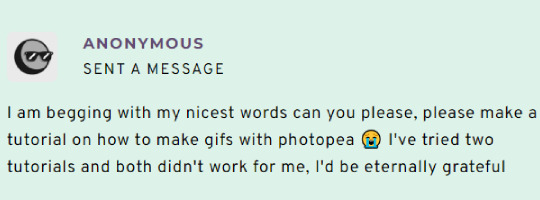
Screencapping
Gif Width/Size Limit/Ezgif
Loading Frames
Cropping and Resizing
Rasterize/Make Frames
Sharpening
Coloring (not detailed. Links to other tutorials included)
Exporting
Obligatory Mentions: @photopeablr ; @miwtual ; @benoitblanc ; @ashleysolsen Definitely check out these blogs for tips, tutorials and resources, they're a gold mine. Finally I recommend browsing the PHOTOPEA TUTORIAL / PHOTOPEA TUTORIAL GIF tags. DISCLAIMER: English is not my first language and I'm not an expert on what I'm going to discuss, so if anything's unclear feel free to drop another ask.
1. SCREENCAPPING -> PotPlayer (the one I use) or MVP or KMPlayer
INSTALL PotPlayer (tutorial)
Play your movie/episode and press Ctrl + G. The Consecutive Image Capturer window will pop up. Click Start to capture consecutive frames, Stop when you got what you needed.
Where it says "Image Type -> Format" I recommend picking PNG, for higher quality screencaps.
To access the folder where the screencaps are stored, type %appdata% in windows search, open the PotPlayerMini64 folder (or 32, depending on your system) and then the Capture folder. That's where you'll find your screencaps.
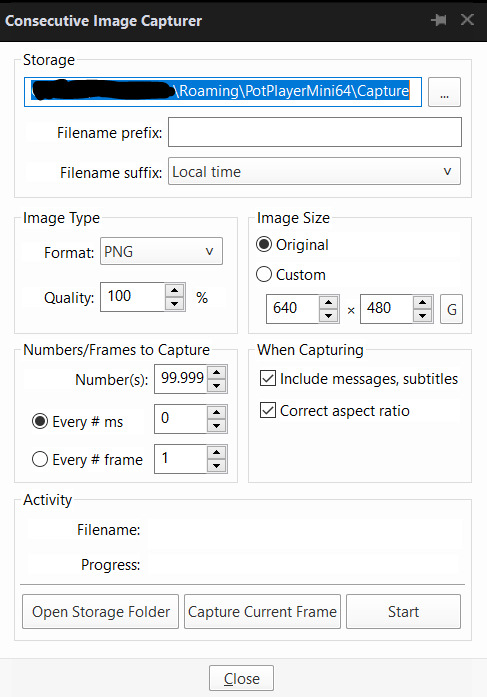
Admittedly MVP is a lot faster but I prefer Potplayer because it generates (at least in my case) higher quality screencaps. MVP kind of alters the hue and it made it harder for me to color my gifs. Still, if you're interested in how to use it, I recommend this tutorial.
As for KMPlayer, every tutorial out there is outdated and I couldn't figure out the new version of the software.
2. GIF WIDTH/HEIGHT, SIZE LIMIT, EZGIF OPTMIZER
At this point you should already know how big your gifs are going to be. Remember the ideal gif width(s) on tumblr are 540 px / 268 px / 177 px. These specific numbers take into account the 4 px space between the gifs. No restrictions on height. Here are some examples:
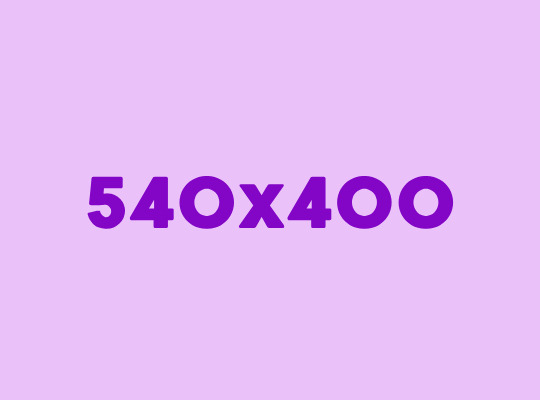



You can play around with the height (177x400, 177x540, 268x200, 268x268, 268x350, 268x400, 540x440, 540x500, 540x540 etc) but if you go over the 10 MB limit you'll either have to make your gifs smaller/delete some frames.
OR you can go on ezgif and optimize your gif, which is usually what I do. The quality might suffer a little, but I'm not really (that) obsessed with how crispy my gifs look, or I'd download photoshop.

Depending on the gif size, you can decrease the compression level. I've never had to go over 35. It's better to start at 5 (minimum) and then go from there until you reach your desired ( <10mb) gif size. Now that I think about it I should have included this passage at the end of the tutorial, I guess I'll just mention it again.
3. LOAD YOUR FRAMES
File -> Open... -> Pick one of your screencaps. The first one, the last one, a random one. Doesn't matter. That's your Background.
File -> Open & Place -> Select all the frames (including the one you already loaded in the previous passage) you need for your gif and load them.
(I recommend creating a specific folder for the screencaps of each gif you're going to make.)
WARNING: When you Place your screencaps make sure the Crop tool is NOT selected, especially if you've already used it and the width/height values have been entered. It will mess things up - I don't know why, could be a bug.
You can either select them all with Ctrl+A or with the method I explained in the ask: "when you want to select more than one frame or all frames at once select the first one, then scroll to the bottom and, while pressing Shift, select the last one. this way ALL your frames will be selected".
WARNING: Depending on how fast your computer is / on your RAM, this process may take a while. My old computer was old and slow af, while my new one can load even a 100 frames relatively fast, all things considered. Even so, I recommend ALWAYS saving your work before loading new frames for a new gif, because photopea might crash unexpectedly. Just save your work as often as you can, even while coloring or before exporting. Trust me, I speak from experience.
Now you can go ahead and delete the Background at the bottom, you won't need it anymore.
4. CROPPING AND RESIZING
Right now your screencaps are still smart objects. Before rasterizing and converting to frames, you need to crop your gif.
Technically you can rasterize/convert to frames and then crop, BUT if you do it in that order photopea will automatically delete the cropped pixels, even if you don't select the "Delete Cropped Pixels" Option. Might be another bug, unclear. Basically, if you crop your gif and then realize you cropped a little too much to the left or the right, you can go ahead, select the Move Tool (shortcut: V) and, after selecting ALL YOUR FRAMES, move them around on your canvas until you are satisfied. You won't be able to do this if you rasterize first and then crop, the excess pixels will be deleted. I don't know why, I found out by accident lol.
CROPPING
(Cropped pixels: the gray/opaque area outside of the selected area. That area disappears once you press enter and crop, but the pixels are retained, so you can move the frames around and reposition them as you like. In this case I could move the frames to the left and include Silver's figure [curly guy in the foreground] in the crop)

After deleting the Background, you will need to select all your frames (using the Shift key), use the C shortcut on your keyboard to choose the Crop tool. Or you can click on it, whatever's more convenient. Once you do that, a dropdown menu is going to appear. You need to select the "FIXED SIZE" option, as shown in the following screencap.

Once you do that, you can type in your desired width and height. Do not immediately press enter.

Your work area should now look like this. Now you can click on one of the white squares and enlarge the selected area until the edges are lined up. You can then move it around until it covers the area you wish to gif.
WARNING: to move the big rectangle around, you're gonna have to click on a random point of the work area, PREFERABLY not to close to the rectangle itself, or you might accidentally rotate it.

See? When your cursor is close to the selected area it turns into this rotating tool. Move it away until it reverts to your usual cursor, then you can start moving the rectangle. Press Enter when you're satisfied with the area you selected.
RESIZE
This isn't always necessary (pretty much never in my case) - and it's a passage I often forget myself - but it's mentioned in most of the tutorials I came across over the years, so I'd be remiss if I didn't include it in mine. After cropping, you'll want to resize your image.
IMAGE -> Image Size...

This window will pop up. Now, should the values in the Width and Height space be anything other than 540 and 400 (or the values you entered yourself, whatever they might be) you need to correct that. They've always been correct in my case, but again. Had to mention it.
5. RASTERIZE & MAKE FRAMES
Now that your screencaps are cropped, you can go ahead and convert them.
LAYER -> Rasterize (if you skip this passage you won't be able to Sharpen (or use any filter) on your frames at once. You'll have to Sharpen your frames one by one.
Photopea doesn't feature a timeline and it's not a video editor, which makes this passage crucial. When you select all your smart objects and try to apply a filter, the filter will only by applied to ONE frame. Once you rasterize your smart objects and make them into frames, you can select them all and sharpen them at once. Unfortunately this also means that you won't be able to - I don't know how to explain this properly so bear with me - use all smart filters/use them in the same way a photoshop user can. For example, you can sharpen / remove noise / add noise / unsharp mask... but you can't act on those filters in the same way a photoshop user can. When you work on smart objects you can change the blend mode - which is critical if you decide to use a filter like High Pass. If you simply apply a high pass filter on photopea you won't be able to change the blend mode and your gif will look like this (following screencaps). Or rather, you will be able to change the blend mode by clicking on the little wheel next to "High pass" (circled in green in the 2nd screencap), but you'll have to apply the filter to each frame manually, one by one.

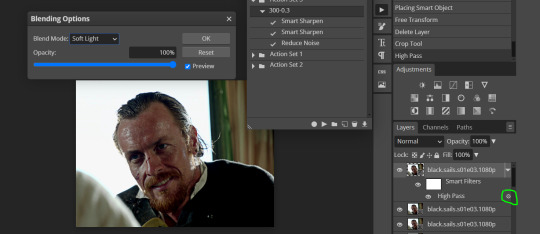
Then you can rasterize/make into frames, but it's extremely time consuming. I did it once or twice when I first started making gifs and it got old pretty soon haha.
Layer -> Animation -> Make frames. This passage will add "_a_" at the beginning of all your frames and it's what allows you to make a (moving) gif. As I said in the ask, if you skip this passage your gif will not move.
6. SHARPENING
Some people prefer to color first and sharpen later, but I found that sharpening filters (more or less) dramatically alter the aspect of your gif and already brighten it a bit (depending on your settings) and you may end up with an excessively bright gif.
Now, sharpening settings are not necessarily set in stone. The most popular ones are 500/0.4 + 10/10, which I use sometimes. But you may also need to take into account the quality of the files you're working with + the specific tv show you're giffing. I've been using different settings for pretty much every tv show I gif, especially in the last couple months. Some examples:

followed by

OR
AMOUNT: 500% RADIUS 0.3px followed by AMOUNT: 20% (or 10%) RADIUS 10px
You'll just need to experiment and see what works best for your gifs.
Some gifmakers use the UNSHARP MASK filter as well (I think it's pretty popular among photopea users?) but it makes my gifs look extra grainy, makes the borders look super bright and it clashes with my coloring method(s), so I use it rarely and with very moderate settings. Something like this:

Again, depends on the gif and on what you like. I've seen it used with great results by other gifmakers!
REDUCE NOISE
Sometimes - and this is especially the case for dark scenes - your gif may look excessively grainy, depending on how bright you want to make it. Reducing noise can help. Keep it mind, it can also make it worse and mess up the quality. BUT it also reduces the size of your gif. Obviously, the higher the settings, the more quality will suffer.


These are my standard settings (either 2/70% or 2/80%). It's almost imperceptible, but it helps with some of the trickier scenes.
ADDING NOISE

Adding noise (1% or 2% max) can sometimes help with quality (or make it worse, just like reduce noise) but it will make your gif so so so much bigger, and occasionally damage the frames, which means you won't be able to load your gif on tumblr, so I rarely use it.
You'll also want to create ACTIONS which will allow you to sharpen your gifs much faster.
HOW TO CREATE AN ACTION ON PHOTOPEA
The Action Button (shaped like a Play button as you can see in the following screencaps) may not be there if you're using photopea for the first time. If that's the case click on the magnifiying glass next to "Account" (in red) and type "actions". Press Enter and the button should immediately show up.
Once you do that, click on the Folder (circled in yellow)


and rename it however you like.

now click on New Action (circled in red). now you can press the Recording button (circled in green)
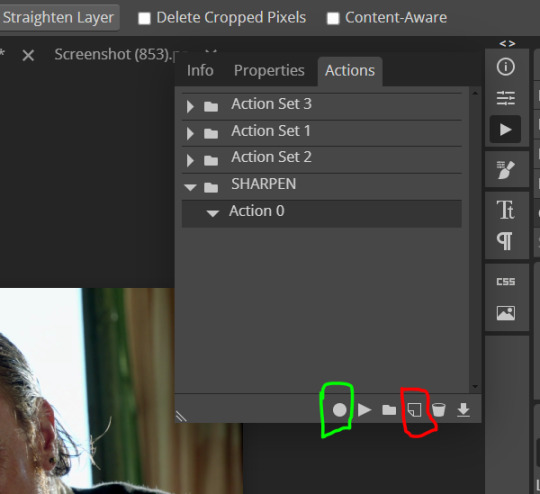
Now
FILTERS -> Smart Sharpen
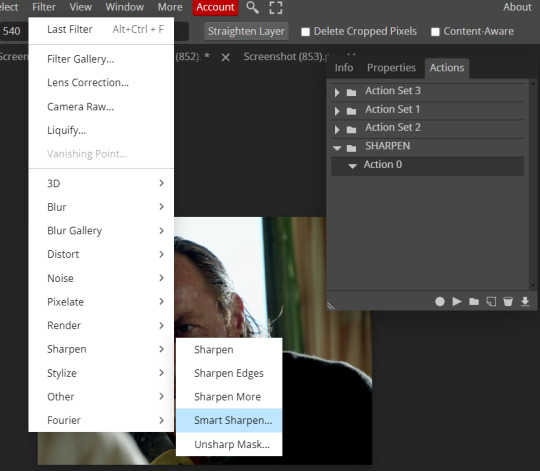
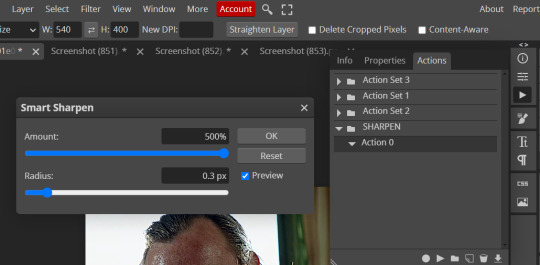
and you can enter your values. Then you repeat this passage (WITHOUT pressing rec, WITHOUT pressing new action or anything else, you just open the smart shapen window again) and, if you want, you can sharpen your gif some more (10%, 10px, or anything you want.)
Maybe, before creating an action, experiment with the settings first and see what works best.
When you're satisfied, you can PRESS STOP (it's the rec button, which is now a square) and you can DOWNLOAD your action (downwards facing arrow, the last button next to the bin. Sorry, forgot to circle it) .

You need to download your action and then upload it on your photopea. When you do, a window will pop up and photopea will ask you whether you wish to load the action every time you open the program. You choose "Okay" and the action will be loaded in the storage.
When you want to sharpen your gif, you select all your frames, then you click on the Play button, and select the Action, NOT the folder, or it won't work.

Actions can also be created to more rapidly crop and convert your frames, but it doesn't always work on photopea (for me at least). The process is exactly the same, except once you start recording you 1) crop your gif as explained in step 4, 2) convert into frames. Then you stop the recording and download the action and upload it. This won't work for the Rasterize step by the way. Just the Animation -> Make Frame step.
7. COLORING
Now you can color your gif. I won't include a coloring tutorial simply because I use a different method for every tv show I gif for. You normally want to begin with a brightness or a curve layer, but sometimes I start with a Channel Mixer layer to immediately get rid of yellow/green filters (there's a tutorial for this particular tool which you will find in the list I mention in the link below)
[Plus I'm not really an authority on this matter as my method is generally... fuck around and find out. Two years of coloring and I still have no idea what I'm doing. 70% of the time.]
Simple Gif Coloring for Beginners -> very detailed + it includes a pretty handy list of tutorials at the bottom.
8. EXPORTING
Now you can export your gif. Some gifmakers export their (sharpened) gifs BEFORE coloring and then load the gifs on photopea to color them. I'm not sure it makes any difference.
FILE -> EXPORT AS -> GIF


(not colored, just sharpened)
As you can see, unlike photoshop the exporting settings are pretty thread bare. The only option available is dither - it sometimes help with color banding - which, and I'm quoting from google for maximum clarity:
"refers to the method of simulating colors not available in the color display system of your computer. A higher dithering percentage creates the appearance of more colors and more detail in an image, but can also increase the file size."
SPEED
When you export your gif, it will play at a very decreased speed (100%). I usually set it at 180/190%, but as for every other tool, you might want to play around a little bit.
GIF SIZE/EZGIF OPTIMIZER (See Step 2)
And that's it.
P.S.: worth repeating
Save your work as often as you can, even while coloring or before exporting.
#photopea#my inbox is open if you have any questions <3#image heavy under the cut#photopeablr#tutorials#gif tutorial#allresources#photopea tutorial#completeresources#gifmaking
415 notes
·
View notes